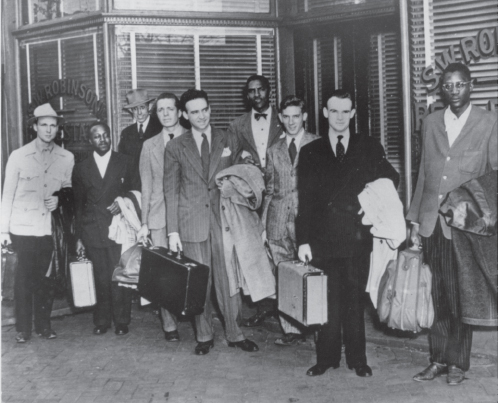Exploring American Histories: Printed Page 771
Exploring American Histories, Value Edition: Printed Page 633
The Postwar Civil Rights Struggle

With the war against Nazi racism and tyranny over, African Americans expected to win first-class citizenship in the United States. During World War II, A. Philip Randolph, a black activist and union leader, had led a successful effort to pressure the federal government to tackle discrimination. New organizations such as the Congress of Racial Equality (CORE) had emerged to attack racial exclusion in public accommodations, and older groups such as the National Association for the Advancement of Colored People (NAACP) had flourished by attracting new members and leading the legal battle against racial inequality. African American veterans returned home to the South determined to build on these victories, especially by extending the right to vote. “A Voteless citizen is a Voiceless citizen” became the slogan of campaigns throughout the South. Yet African Americans found that most whites resisted demands for racial equality.
Violence surfaced as the most visible evidence of many white people’s determination to preserve the traditional racial order. In 1946 a race riot erupted in Columbia, Tennessee, in which blacks were killed and black businesses were burned down. In February 1946 in South Carolina, Isaac Woodard, a black veteran still in uniform and on his way home on a bus, got into an argument with the white bus driver. When the local sheriff arrived, he pounded Woodard’s face with a club, permanently blinding the ex-GI. Five months later, the Ku Klux Klan in Monroe, Georgia, shot a black veteran and three members of his family to death for “acting uppity.” In Mississippi, Senator Theodore Bilbo, running for reelection in the Democratic primary, told his white audiences that they could keep blacks from voting “by seeing them the night before” the election. Groups such as the NAACP and the National Association of Colored Women demanded that the president take action to combat this reign of terror.
In December 1946, after meeting with a delegation of concerned African Americans, Truman issued an executive order creating the President’s Committee on Civil Rights to investigate the situation and report back to him. Truman’s response reflected moral concerns and good politics: It provided the opportunity to increase Democratic Party support among African Americans, which Roosevelt had first succeeded in gaining in 1936. In April 1947, while the President’s Committee on Civil Rights conducted its work, Jackie Robinson achieved a milestone by becoming the first black baseball player to enter the major leagues. This accomplishment proved to be a sign of changes to come.
After extensive deliberations, the committee, which consisted of blacks and whites, northerners and southerners, issued its report, To Secure These Rights, on October 29, 1947. The document placed the problem of what it called “civil rights shortcomings” within the context of the Cold War, arguing that racial inequality and unrest could only aid the Soviets in their global anti-American propaganda efforts. “The United States is not so strong,” the committee asserted, “the final triumph of the democratic ideal not so inevitable that we can ignore what the world thinks of us or our record.” A far-reaching document, the report called for racial desegregation in the military, interstate transportation, and education, as well as extension of the right to vote. The following year, in the midst of the presidential election and once again pressured by A. Philip Randolph, the president signed an executive order to desegregate the armed forces.
Explore
See Document 24.5 for an excerpt from To Secure These Rights.